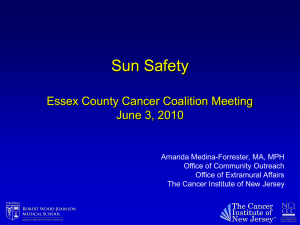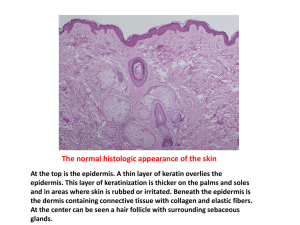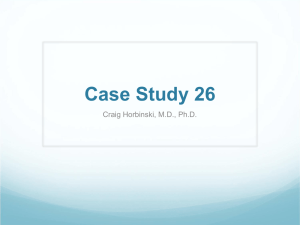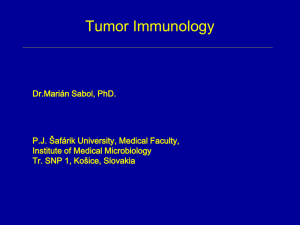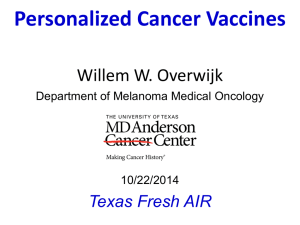Update on Malignant Melanoma
advertisement
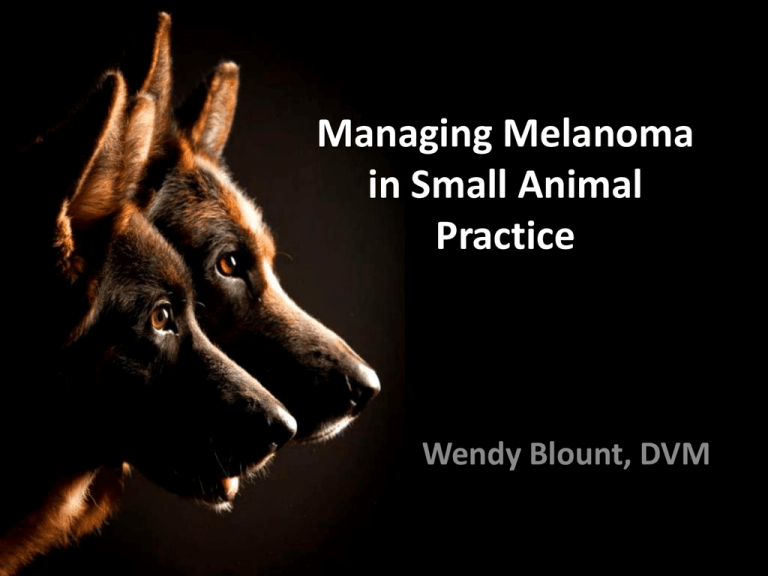
Managing Melanoma in Small Animal Practice Wendy Blount, DVM Canine Melanoma • 4% of all canine tumors • Most common oral tumor in the dog • Like grade II MCT, relatively unpredictable tumors – Spontaneous regression of metastasis is more likely with this tumor compared to others – Benign histopath is sometimes followed by malignant behavior – Malignant histopath is sometimes followed by benign behavior – Studies are not always repeatable Oral Tumors in Dogs • Malignant melanoma most likely • Others: – Squamous cell carcinoma – fibrosarcomas – Epulides and other odontogenic tumors Diagnosis - Cytology • Melanocytes can be identified on cytology if granulated • Spindle, round or epithelioid cells • Must be distinguished from “melanophages” occurring with dermatopilic lymphoid hyperplasia in dark skinned dogs – Macrophages that have taken up melanin Diagnosis - Cytology • Melanin granules – Range from clear to golden to dark browngreen-black – Fine, coarse or needle-like – Can be intracellular and/or extracellular • Tumors containing clear melanosomes are the most malignant and called “amelanotic melanoma” – May require immunohistochemistry to differentiate from anaplastic sarcoma Diagnosis - Cytology Mass Cytologies Diagnosis - Cytology Mass Cytologies Diagnosis - Cytology Mass Cytologies Diagnosis - Cytology Mass Cytologies Diagnosis - Cytology Mass Cytologies Diagnosis - Cytology Mass Cytologies Diagnosis - Cytology • Lymph node aspirates – Mesenchymal cells containing melanin granules in clusters = metastasis – Macrophages seen singly containing melanin = dermatophilic lymph node hyperplasia – Melanocytoma cells filling the node = metastasis Diagnosis - Cytology Lymph Node Cytologies Staging Why stage melanomas? • Prognosis for melanoma is extremely variable – tumor stage is a prognosticating variable • Why take a biopsy if cytology is diagnostic? – Histopathologic parameters affect prognosis – Dirty borders indicate more surgery if possible • most important for the most malignant – Cats with iris masses – Dogs with masses on digits and in the mouth Staging – Oral Melanomas • Stage I – <2cm tumor diameter • Stage II - 2-4cm tumor diameter • Stage III - >4cm tumor diameter – And/or lymph node metastasis • Stage IV – distant metastasis Is a 2 cm tumor the same in a Rottweiler and a chihuahua? • Patient size has not been considered with respect to tumor size and staging Staging – Digital Melanomas • Stage I – <2cm tumor and superficial • Stage II - 2-5cm tumor, minimal invasion • Stage III - >5cm tumor diameter – And/or subcutis invasion • Stage IV – invading fascia or bone • Metastasis free interval inversely associated with tumor stage Staging • CBC, Profile, UA • 3 view chest films • local lymph node aspiration and cytology – ipsilateral and contralateral nodes for oral melanoma due to variability in draining patterns – whether lymphadenomegaly is present or not • 70% of enlarged lymph nodes contain metastasis • 40% of normal sized lymph nodes contain metastasis • abdominal ultrasound especially if “hot” location – oral cavity & mucosal surface of the lips – Feet – US abdominal lymph nodes, liver, adrenal glands Treatment • Surgery – mainstay for melanomas on haired skin • Typically behave benignly – Oral and digital melanomas typically behave malignantly (oral even more so) • Oral melanosarcomas may or may not be resectable (especially maxillary) • Toes usually amputated for histopath • Chemo is often ineffective • Radiation - melanomas respond well Treatment Palliative Therapy • Piroxicam – inhibition of cyclooxygenase 2 (COX-2) expressed on carcinoma cells • cyclo-oxygenases lead to the formation of prostaglandins • Prostaglandins (E2 series) inhibit natural killer (NK) cell function • NK cells recognize tumor associated cell surface antigens and may mediate cell death – Inhibition of tumor angiogenesis Treatment Treatment Palliative Therapy • Piroxicam – Unlikely to shrink the tumor significantly – Likely will palliate tumor associated pain and inflammation – May slow progression of disease – Other COX2 inhibitors might be equally effective with fewer side effects • GI bleeding, nephrotoxicity – 0.3 mg/kg PO SID to QOD – Monitor BUN/creat Treatment Palliative Therapy • Cimetidine – – – – Supportive studies in horses promote apoptosis in some cancers inhibit angiogenesis enhance the host immune response against tumor cells by blocking T-cell suppression – Block cell growth-promoting activity of histamine in colon cancer and melanoma cell lines – Might be used to promote stable disease or treat small amounts of microscopic disease, and would NOT expect to decrease the size of gross disease – COX2 inhibitor better choice for antiangiogenesis Treatment – Oral Melanomas Surgery • Maxillectomy and mandibulectomy carry inherent morbidity • Client satisfaction with this procedure is 85-90% • Complete staging is indicated with larger resections – Distant metastasis would preclude large resection, as survival is likely months Treatment – Oral Melanomas Radiation therapy • effective for local control • Indicated when: – Tumor not resectable – Couldn’t get clean borders on resection – Lymph node but not distant metastasis • Coarse fractionation better than fine – Larger less frequent doses – Once a week to every other week Treatment – Oral Melanomas Is chemo helpful after surgery? • Not really • Two studies show that chemo plays an insignificant role in management of canine melanoma Treatment – Melanoma Vaccine • Targets the tyrosinase family • Tyrosinase is a glycoprotein in the melanosome essential to melanin synthesis • Immunization induces antibodies and cytotoxic T-cells against melanoma • Conditionally licensed in 2007 and fully licensed in 2009 • Oncept Treatment – Melanoma Vaccine • Works best when there is minimal residual disease after surgery • Digital melanoma (Manley et al, JVIM 2011) – improved survival compared to digit amputation only – decreased prognosis for dogs with advanced stage disease – Decreased prognosis with increased time from amputation to start of vaccination Treatment – Melanoma Vaccine • $500 per dose – COST • 1 injection every 2 weeks for 4 treatments • Then every 6 months for 2 years • Total drug cost $4,000 • Usually sold 4 doses ($2,000) at a time Prognosis • Extremely variable • Depends on: – Anatomic site – Tumor size – Stage – Histology Prognosis – Digital Melanomas • Amputation with no metastasis to lymph node or elsewhere – Median survival 12 months – 50% alive at one year – 11-13% alive at 2 years – Undetected metastasis is common • 30-40% have already metastasized at presentation Prognosis – Oral Melanomas • almost all oral and other mucosal melanomas behave malignantly – Likely to invade locally – High propensity for distal metastasis • Factors affecting prognosis – tumor size (see staging) – Incomplete surgical margins is worse – Location – caudal mandibular, rostral maxillary are worse – Mitotic index > 3/HPF is worse – Bony invasion (osteolysis) is worse Prognosis – Oral Melanomas • Phil Bergman reports clinical experience – A handful of cases each year with benign histopath and malignant behavior • Bostock et al (Vet Pathol 2001) – 3/7 dogs with benign histopathology die of malignant melanoma histopathology might not always predict tumor behavior well Prognosis – Oral Melanomas • With surgery only (MacEwen et al) – Stage I – 17-18 months – Stage II – 5-6 months – Stage III – 3 months • Surgery plus radiation and/or chemo – Stage I – 12-15 months • Dogs die of metastasis, not local recurrence – Sx not usually recommended for stage IV Radiation and chemo do not prevent metastasis Prognosis – Oral Melanomas Is chemo helpful for stage IV oral melanoma? • Median survival 1 month, ranging from weeks to months • Carboplatin – 28% respond, most partial responses – Virtually none are durable responses – 72% do not respond Prognosis – Oral Melanomas radiation treatments when unresectable • 50-70% complete remission • 25-30% partial remission • Up to 25% do not respond • Recurrance or distant metastasis is usual • Can increase quality of life significant by removing the oral lesion • May not increase survival time Prognosis – Other Melanomas on Haired Areas • Melanomas on haired skin NOT proximal to mucosal margins or toes behave benignly – Surgery is usually curative – Histopath is recommended, though somewhat less predictive compared to other tumors • Imperative for evaluation of surgical borders • Prognostic immunohistopathology is available at AMC and MSU – AMC - Flaherty Comparative Oncology Laboratory (212-329-8675) – MSU Brochure - MSU Form Prognosis – Other Melanomas on Haired Areas • Malignant haired skin melanomas are rare but possible – 45% of dogs with malignant skin tumors die of their disease within 1 year • Melanoma histopath is prone to inaccuracy – 8% of dogs with skin melanomas of benign histopath die of melanoma • Mitotic index is important – 10% of dogs with haired-skin melanoma of mitotic index <2 died from their tumor within 2 years – >70% of dogs with mitotic index >3 die within 2 years Prognosis – Other Melanomas on Haired Areas Take Home Points Malignant haired skin melanomas are the exception rather than the rule • But when they are malignant, they still behave poorly • Cutaneous melanomas should be removed Stage I skin melanoma (<2cm) with benign histopath and clean borders does not get a clean bill of health • 1 out of 12-13 (8%) die of melanoma • The rest are cured Prognosis – Other Melanomas on Haired Areas Indications that a melanoma has been removed – SEND FOR HISTOPATH • Cytology – do a scraping after removal, before you put the mass in formalin • Pigmentation of the tumor Client Handout on Melanoma Prognosis – Other Melanomas on Haired Areas Prognosis – Other Melanomas on Haired Areas Prognosis – Other Melanomas on Haired Areas Prognosis – Other Melanomas on Haired Areas Prognosis – Other Melanomas on Haired Areas Prognosis – Other Melanomas on Haired Areas Ocular Melanoma • Usually arise in the anterior chamber • Rarely arise from the eyelid, orbit or conjunctiva, or posterior uvea • Behavior is different from the melanomas of melanocyte origin – Ocular melanomas are of neuroectodermal origin rather than mesenchymal origin as in the rest of the body Ocular Melanoma Cats • Significant risk of metastatic disease and tumor related mortality – Mortality 30-50% when neglected • Diffuse transformation of melanocytes on the anterior iris surface – CC – “one eye changed color” – CC – “pupil is always dilated” • Prolonged pre-malignant phase – Look like iris freckles and nevi – Metastasis can take 2-3 years to develop Ocular Melanoma Cats • Distinguishing nevi from malignancy – Nevi are static or slowly evolving single or multiple pigmented lesions • Can appear elevated and slowly enlarge • Can appear as bilateral concentric rings of pigmentation (target eyes) – Malignancies progress over time • Diffuse or coalescing multifocal proliferation • Cells exfoliate into the anterior chamber and can cause glaucoma • Tumor emboli in scleral vessels – grave prognosis Ocular Melanoma Cats • Recheck dark spots on the iris every 3-4 months • Significant progression since the last visit indicates removal of the eye • Glaucoma indicates the same • Iridectomy or laser ablation reserved for slowly growing isolated pigmented iridal lesions which are likely benign Ocular Melanoma Cats Ocular Melanoma Cats Ocular Melanoma Cats Ocular Melanoma Cats Ocular Melanoma Cats Ocular Melanoma Cats Ocular Melanoma Cats Ocular Melanoma Cats • Limbal melanocytomas • Limbus – where cornea meets sclera • Most common in superior quadrants • Gonioscopy required to distinguish from scleral metastasis of melanoma • Removal not indicated if benign behavior • Growing lesions removed by an ophthalmologist (may require graft) Ocular Melanoma Cats Ocular Melanoma Dogs Ocular Melanoma Dogs • The vast majority are benign (90%) • Only 50% of those classified by histopath as malignant actually metastasize after removal of the eye – Mortality of uveal melanoma 5% • Most arise from the anterior uvea • Choroidal and limbal melanomas less common • Freckles and nevi also common Ocular Melanoma Dogs • Uveal melanocytoma – can destroy the globe and cause glaucoma – Removal of the eye is curative – Same recheck schedule as for cats – Same treatment – Better prognosis (95% cure rate) – Staging prior to enucleations is indicated, but low yield Ocular Melanoma Dogs • Limbal melanocytoma – GSD and Labrador predisposed – Usually superior quadrant – Growth rate variable – Rarely affect vision or cause glaucoma – Often accompanied by margin of corneal lipid dystrophy – Gonioscopy can evaluate for local invasion in rare case of malignancy Ocular Melanoma Dogs • ocular melanocytoma – Usually bilateral – Older terriers – Insidius panuveal proliferation – Hyperpigmentation of the iris – Free floating cells in the anterior chamber and adhering to the anterior lens – Progresses to graying of the sclera – Can result in glaucoma – Almost never metastasizes Ocular Melanoma Dogs Ocular Melanoma Dogs Ocular Melanoma Dogs Ocular Melanoma Dogs Acknowledgements Robert L. Peiffer, Jr., DVM, PhD, DACVO • School of Medicine, Univ North Carolina Chapel Hill, NC Philip J. Bergman, DVM, MS, PhD, DACVIM (Oncology) • VIN Consultant Chief Med Off, BrightHeart Vet Centers Michael H. Goldschmidt, BVMS & Patricia McManus, VMD, PhD • University of Pennsylvania School of Veterinary Medicine Acknowledgements Hazelyn Patterson, DVM and Kenneth S. Latimer, DVM, PhD • Department of Pathology (Latimer) CVM, The University of Georgia Athens, GA VDIC – Veterinary Diagnostic Imaging Center • Clackamas, OR Claudia Barton, DVM, ACVIM • TAMU CVM Acknowledgements Maristavet.com TheCatSite.com VeterinaryVision.com VetBook.org EyeVet.info ScienceDirect.com FelineDiabetes.com PetMD.com




